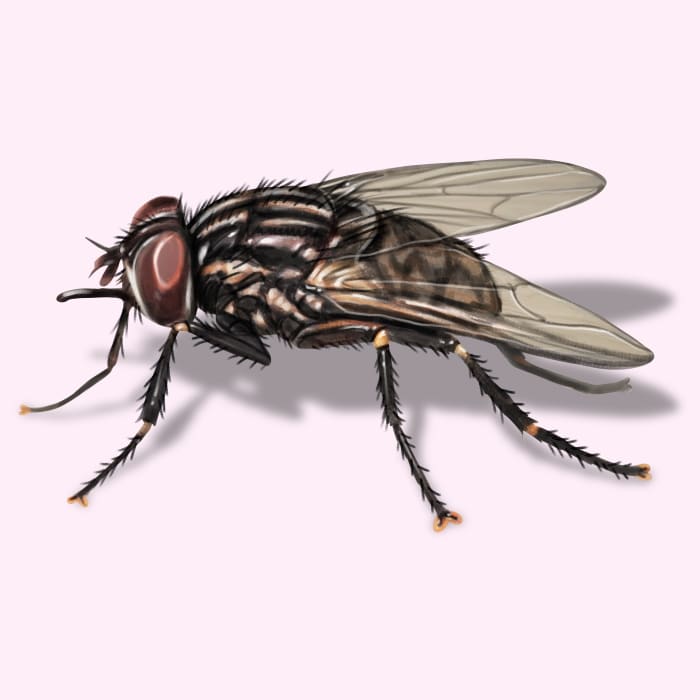How to identify and get rid of stable flies

Bitten by a fly? It might just be a stable fly in disguise
Have you ever been bitten by what looked like a housefly and wondered how that happened? Has your conception of those annoying flies been wrong all this time?
No, you just encountered a house fly's blood-sucking cousin, the stable fly.
Stable flies like to hang around… you guessed it… stables. They prefer to bite and suck the blood of large warm-blooded animals like cattle or horses. If the opportunity arises, they can sometimes take a sip from a human host, too!
These flies don't have the sponging mouthparts that house flies use to slurp up liquid. Instead, they have a long, lance-like mouthpart that they use to bite through the skin and suck up blood. Both males and females feed on blood. The males will die after mating, but the females will lay their eggs in old manure of stable animals, compost piles, old grass clipping piles or urine-soaked straw.
Stable flies aren't usually a big problem for homeowners, as these flies rarely come inside. They will likely be a problem for people with pets and farm animals.
How to identify stable flies
Stable flies can be identified by their gray bodies and checkerboard patterns on their abdomen. You'll also notice large dots on the top of the abdomen.
Like the housefly, the stable fly will have black and gray stripes on its thorax, red eyes, and only two wings.
Also, their wings won't overlap much when they rest, unlike other common flies. If you find yourself with itchy bites around your ankles or see these flies persistently around your home, especially where pets rest or livestock are kept, you've likely got stable flies on your hands.
How big are stable flies?
Stable flies grow to about ¼ inch long.
What other pest looks like a stable fly?
The house fly will look the most similar to a stable fly. The way to tell the difference includes:
- Stable flies have – a lance-like mouthpart, dots on the abdomen
- House flies have – a thick, sponging mouthpart, lack dots on the abdomen
Where do stable flies live?
They are found all over the United States, particularly in agricultural areas or places with livestock. Look for them near animal bedding, aged manure piles, or compost heaps. Inside the house, they might be found near windows or doors, trying to escape back outside.
How to get rid of stable flies
The best way to control stable flies is with prevention and sanitation. If you have farm animals or pets in a stable or pen, you want to make sure you clean up any waste or manure frequently. Also, remove any old hay, soiled animal bedding, and spilled feed.
Fly traps placed near stables or corrals can help trap and control flies.
If you have stable flies on your porch or in your home, consider these tips:
- Air movement with fans
- Repair and install window and door screens
- Clean up grass piles in your yard
Spraying a perimeter insect spray around your home can also prevent flies from entering or clustering around windows and doors. Pestie offers a DIY, pro-grade solution that is easy to apply and comes to your door at the right time to apply. You can save hundreds on pest control without the need for an exterminator.
Treat stable flies with Pestie
If you're still having trouble keeping stable flies away, the best option is to use a pro-grade, effective pest control solution like Pestie.
Pestie is a do-it-yourself pest control solution that's specially designed to keep stable flies and other pests away from your home.
With Pestie, you can rest easy knowing that your living space is protected and free of creepy crawlies. And the best part? It's designed for people, pets, and the planet, so you can say goodbye to harsh chemicals and hello to peace of mind!
- Save hundreds compared to traditional annual pest plans
- People, pet, and planet-friendly
- Pro-grade customized formulas
Quick facts
How dangerous are Stable Flies?
Medium danger risk
While not directly causing human diseases, their bites are painful and can lead to discomfort and potential allergic reactions.
- Scientific name
Stomoxys calcitrans
- Other common names
Barn Flies, Biting House Flies, Dog Flies, Power Mower Flies
- Colors
gray with black stripes
- Life span
2-3 weeks
- Diet
Blood
Stable flies are attracted to carbon dioxide and fresh blood. Additionally, they are attracted to a plexiglass product called Alsynite!








